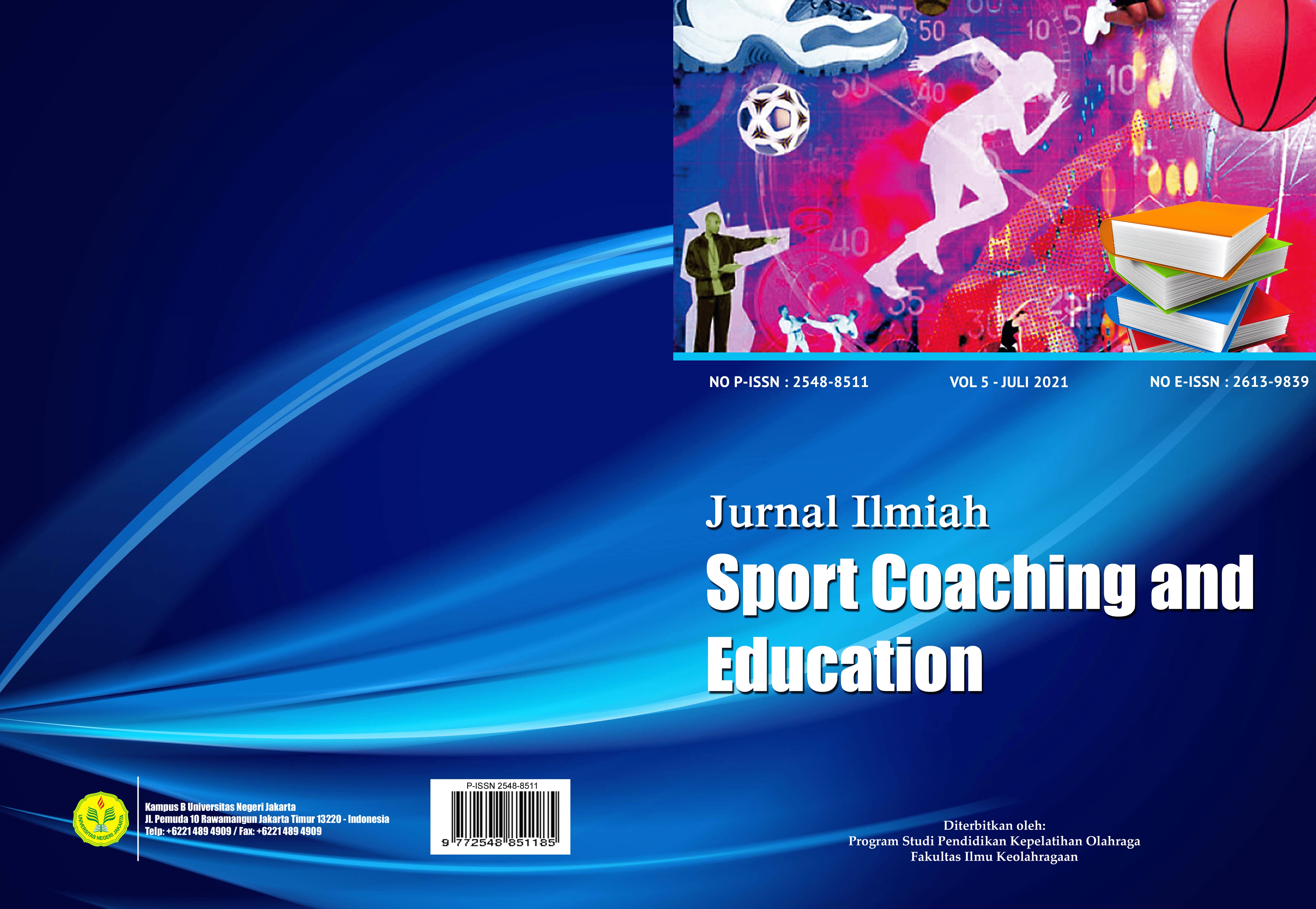Analisis Fleksibilitas Pada Atlet Bulutangkis Junior Indonesia
Flexibility Analysis
Abstract
ABSTRAK
Tujuan penelitian ini adalah untuk mengukur fleksibilitas dan mengetahui riwayat cedera yang dimiliki atlet bulutangkis junior pria dan wanita. Dalam penelitian ini melibatkan total 49 atlet bulutangkis. Secara spesifik, mereka dibagi menjadi dua (2) group berdasarkan jenis kelamin mereka. Group laki-laki (n = 26), yang memiliki rata-rata tinggi badan = 171.2 ± 6.91 cm ; berat badan = 64.02 ± 9.67 Kg; BMI = 21.89 ± 2.49 Kg/m2, sedangkan Group perempuan (n = 23) memiliki rata-rata tinggi badan = 159.09 ± 3.40 cm ; berat badan = 56.79 ± 9.40 Kg; BMI = 22.39 ± 3.08 Kg/m2. Seluruh peserta diminta untuk melakukan test fleksibilitas menggunakan alat Takei 5003 Analogue Standing Trunk Flexion Meter dan mengisi kuesioner terkait rewayat cedera visual analogue scale questioner (VAS). Analisis statsitik menunjukkan bahwa atlet bulutangkis wanita junior memiliki fleksibilitas yang lebih baik dibandingkan dengan atlet bulutangkis pria junior (p = 0.001). Di sisi lain, VAS questioner menunjukkan bahwa 9% dari total 26 atlet pria pernah mengalami riwayat terapi selama lebih dari 3 bulan, sedangkan tidak ada satupun dari 23 atlet wanita (0%) yang memiliki riwayat terapi penyembuhan lebih dari 3 bulan. Penelitian ini menunjukkan secara kuantitatif bahwa atlet wanita bulutangkis memiliki kemampuan fleksibilitas yang lebih baik dibandingkan dengan atlet bulutangkis pria, sehingga memiliki korelasi terkait resiko terjadinya suatu cedera dan riwayat penanganan terapi yang lebih baik dibandingkan atlet bulutangkis pria.
Kata Kunci: Bulutangkis, Cedera, Fleksibilitas, Performa, Sendi.
ABSTRACT
The aim of this study was to measure flexibility and determine the injury history of male and female junior badminton athletes. This study involved a total of 49 badminton athletes. Specifically, they were divided into two (2) groups based on their gender. Male group (n = 26), who had a mean height = 171.2 ± 6.91 cm; body weight = 64.02 ± 9.67 Kg; BMI = 21.89 ± 2.49 Kg / m2, while the female group (n = 23) had an average height = 159.09 ± 3.40 cm; body weight = 56.79 ± 9.40 Kg; BMI = 22.39 ± 3.08 Kg / m2. All participants were asked to do a flexibility test using the Takei 5003 Analogue Standing Trunk Flexion Meter tool and fill out a questionnaire related to visual injury analogue scale questioner (VAS). Statistical analysis showed that female junior badminton athletes had better flexibility than junior male badminton athletes (p = 0.001). On the other hand, the VAS questionnaire showed that 9% of the total 26 male athletes had a history of therapy for more than 3 months, whereas none of the 23 female athletes (0%) had a history of healing therapy for more than 3 months. This study shows quantitatively that female badminton athletes have better flexibility abilities than male badminton athletes, so that they have a better correlation related to the risk of an injury and a history of treatment treatment compared to male badminton athletes.
Keywords: Badminton, Injury, Flexibility, Performance, Joints.
References
Apriantono, T., Herman, I., Winata, B., Hidayat, I. I., Hasan, M. F., Juniarsyah, A. D., & Ihsani, S. I. (2020). Physiological characteristics of Indonesian junior badminton players: Men’s double category. International Journal of Human Movement and Sports Sciences, 8(6), 444–454. https://doi.org/10.13189/saj.2020.080617
Askling, C., Saartok, T., & Thorstensson, A. (2006). Type of acute hamstring strain affects flexibility, strength, and time to return to pre-injury level. British Journal of Sports Medicine, 40(1), 40–44. https://doi.org/10.1136/bjsm.2005.018879
Gleim, G. W., & McHugh, M. P. (1997). Flexibility and its effects on sports injury and performance. Sports Medicine, 24(5), 289–299. https://doi.org/10.2165/00007256-199724050-00001
Grimston, S. K., Nigg, B. M., Hanley, D. A., & Engsberg, J. R. (1993). Differences in Ankle Joint Complex Range of Motion as a Function of Age. Foot & Ankle International, 14(4), 215–222. https://doi.org/10.1177/107110079301400407
Huang, P., Fu, L., Zhang, Y., Fekete, G., Ren, F., & Gu, Y. (2019). Biomechanical analysis methods to assess professional badminton players’ lunge performance. Journal of Visualized Experiments, 2019(148), 1–8. https://doi.org/10.3791/58842
Kubo, K., Kanehisa, H., Azuma, K., Ishizu, M., Kuno, S. Y., Okada, M., & Fukunaga, T. (2003). Muscle architectural characteristics in young and elderly men and women. International Journal of Sports Medicine, 24(2), 125–130. https://doi.org/10.1055/s-2003-38204
Lin, W. C., Lee, C. L., & Chang, N. J. (2020). Acute effects of dynamic stretching followed by vibration foam rolling on sports performance of badminton athletes. Journal of Sports Science and Medicine, 19(2), 420–428.
Liveira, L. O., Emos, A. D. L., Alles, B. E. S., Eite, T. H. L., Hea, M. A. R., & Eis, V. I. M. A. R. (2011). The influence of strength, flexibility, and simultaneous training on flexibility and strength gains. Journal of Strength and Conditioning Research, 25(5), 1333–1338.
Machado, L., Thompson, L. M., & Brett, C. H. R. (2018). Visual analogue mood scale scores in healthy young versus older adults. International Psychogeriatrics, 1–8. https://doi.org/10.1017/S1041610218000996
Mahady, S. E. (2011). Adding flexibility to physician training. Medical Journal of Australia, 194(9), 460–462. https://doi.org/10.5694/j.1326-5377.2011.tb03061.x
Morse, C. I. (2011). Gender differences in the passive stiffness of the human gastrocnemius muscle during stretch. European Journal of Applied Physiology, 111(9), 2149–2154. https://doi.org/10.1007/s00421-011-1845-z
O’Sullivan, K., Murray, E., & Sainsbury, D. (2009). The effect of warm-up, static stretching and dynamic stretching on hamstring flexibility in previously injured subjects. BMC Musculoskeletal Disorders, 10, 1–9. https://doi.org/10.1186/1471-2474-10-37
Otsuki, A., Muraoka, Y., Fujita, E., Kubo, S., Yoshida, M., Komuro, Y., … Kuno-Mizumura, M. (2016). Gender differences in muscle blood volume reduction in the tibialis anterior muscle during passive plantarflexion. Clinical Physiology and Functional Imaging, 36(5), 421–425. https://doi.org/10.1111/cpf.12232
Parker, B. A., Smithmyer, S. L., Pelberg, J. A., Mishkin, A. D., Herr, M. D., & Proctor, D. N. (2007). Sex differences in leg vasodilation during graded knee extensor exercise in young adults. Journal of Applied Physiology, 103(5), 1583–1591. https://doi.org/10.1152/japplphysiol.00662.2007
Phomsoupha, M., & Laffaye, G. (2015). The Science of Badminton: Game Characteristics, Anthropometry, Physiology, Visual Fitness and Biomechanics. Sports Medicine, 45(4), 473–495. https://doi.org/10.1007/s40279-014-0287-2
Somerset, S., & Hoare, D. J. (2018). Barriers to voluntary participation in sport for children: A systematic review. BMC Pediatrics, 18(1). https://doi.org/10.1186/s12887-018-1014-1
van Dyk, N., Farooq, A., Bahr, R., & Witvrouw, E. (2018). Hamstring and Ankle Flexibility Deficits Are Weak Risk Factors for Hamstring Injury in Professional Soccer Players: A Prospective Cohort Study of 438 Players Including 78 Injuries. American Journal of Sports Medicine, 46(9), 2203–2210. https://doi.org/10.1177/0363546518773057



